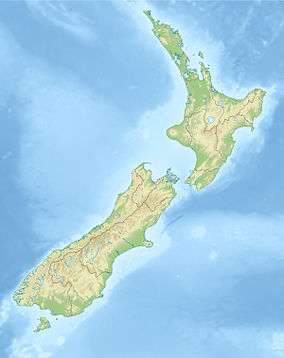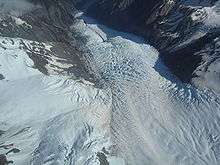Franz Josef Glacier
| Franz Josef Glacier / Kā Roimata o Hine Hukatere | |
|---|---|
|
Franz Josef Glacier, as photographed from the valley floor | |
| Location | Westland Tai Poutini National Park |
| Coordinates | 43°28′1.21″S 170°11′29.5″E / 43.4670028°S 170.191528°ECoordinates: 43°28′1.21″S 170°11′29.5″E / 43.4670028°S 170.191528°E |
| Length | 12km |
| Status | Receding |

Franz Josef Glacier / Kā Roimata o Hine Hukatere is a 12 km (7.5 mi) long[1] temperate maritime glacier located in Westland Tai Poutini National Park on the West Coast of New Zealand's South Island. Together with the Fox Glacier 20 km (12 mi) to the south, and a third glacier, it descends from the Southern Alps to less than 300 metres (980 ft) above sea level.[2]
The area surrounding the two glaciers is part of Te Wahipounamu, a World Heritage Site park. The river emerging from the glacier terminal of Franz Josef is known as the Waiho River.[3]
Naming
The first European description of one of the west coast glaciers (believed to be Franz Josef) was made in the log of the ship Mary Louisa in 1859.[4] The glacier was later named after Emperor Franz Joseph I of Austria by the German explorer, Julius von Haast in 1865. The Māori name for the glacier is Kā Roimata o Hine Hukatere ('The tears of Hine Hukatere'), arising from a local legend: Hine Hukatere loved climbing in the mountains and persuaded her lover, Wawe, to climb with her. Wawe was a less experienced climber than Hine Hukatere but loved to accompany her until an avalanche swept Wawe from the peaks to his death. Hine Hukatere was broken-hearted and her many, many tears flowed down the mountain and froze to form the glacier. Following the passage of the Ngai Tahu Claims Settlement Act 1998, the name of the glacier was officially altered to Franz Josef Glacier / Kā Roimata o Hine Hukatere.[5]
Advance and retreat


Franz Josef Glacier is currently 12 km (7.5 mi) long and terminates 19 km (12 mi) from the Tasman Sea. Fed by a 20-square-kilometre (7.7 sq mi) large snowfield[7] at high altitude, it exhibits a cyclic pattern of advance and retreat, driven by differences between the volume of meltwater at the foot of the glacier and volume of snowfall feeding the névé. Franz Josef Glacier had periods of advances from 1946 to 1951 (340 m), 1965–1967 (400 m), 1983–1999 (1420 m) and 2004–2008 (280 m).[8] The glacier advanced rapidly during the Little Ice Age, reaching a maximum in the early eighteenth century.[9] Having retreated several kilometres between the 1940s and 1980s, the glacier entered an advancing phase in 1984 and at times has advanced at the phenomenal (by glacial standards) rate of 70 cm a day. The flow rate is about 10 times that of typical glaciers. Over the longer term, the glacier has retreated since the last ice age, and it is believed that it extended into the sea some 10,000 to 15,000 years ago.
This cyclic behaviour is well illustrated by a postage stamp issued in 1946, depicting the view from St James Anglican Church. The church was built in 1931, with a panoramic altar window to take advantage of its location. By 1954, the glacier had disappeared from view from the church, but it reappeared in 1997. This is due to the highly variable conditions on the snowfield, which take around 5–6 years before they result in changes in the terminus location.[7]
The glacier was still advancing until 2008, but since then it has entered a very rapid phase of retreat.[10] As is the case for most other New Zealand glaciers which are mainly found on the eastern side of the southern alps, the shrinking process is attributed to global warming.[11]
There have been some incidents of jökulhlaups (outbreak floods from water-filled ice tunnels) at the glacier, with one destroying a bridge on the access route in 1989.[7]
Based on past variations, scientists expect that Franz Josef Glacier will retreat 5 km and lose 38% of its mass by 2100 in a mid-range scenario of warming.[12]
The Waiho Loop
The Waiho Loop is the terminal moraine of the glacier, and indicates the extent of the Franz Josef Glacier, about 12,000 years ago. Too rugged to be cleared for farming it remains covered in native forest.[13][14]
Tourism
The glacier area is one of the main tourist attractions of the West Coast, with around 250,000 visitors a year,[7] and up to 2,700 per day (2007).[15] Guided and unguided walks up to and onto the glacier are possible. However, since April 2012 all glacier walks require a helicopter flight past the unstable terminal face. Glacier walks also require some specialised equipment, namely ice axes and crampons that latch onto a sturdy boot. These are usually provided by tour companies.
As the walking part of any tour up to the glacier takes a long time, and ends at the first icefall (a frozen waterfall, draping a natural step in the land underneath), many tourists book helicopter tours from one of the several local airlines, which usually drop their guests between the first and second icefalls, for a guided 1–2 hour walk through the broken ground atop the glacier. Although the glacial landscape changes almost daily, given the glacier's unusually fast flow, and some walks including passages through ice tunnels, they are still considered quite safe and only somewhat strenuous.

In June 2010, an Australian tourist died of a heart attack during a guided hike of the glacier.[16] [17]
At the entrance of the valley lies Franz Josef township, a small service village with a permanent population of approximately 330 residents. It is situated 5 km from the glacier on State Highway 6 and has a petrol station, small but busy heliport, numerous tourist accommodation options (with up to 2,000 people staying overnight during the main season) and a number of restaurants and shops.[2][3] Just south of the village, a sealed road leads from the highway into the Franz Josef Glacier valley and to a car park. Several small walks start from the Valley Road and the car park, and it is also possible to comfortably cycle from Franz Josef township to the car park.[18]

As of 2015, the valley walk ends at a lookout about 50 m from the main terminal face of the glacier. Since around 2012 the terminal face has become too dangerous to approach, signs warn against crossing the safety barriers at the lookout.
An alternative option to view the glacier is via the 8 hour day hike up the 1,303 metres (4,275 ft) high Alex Knob, overlooking the Franz Josef Glacier and valley below. The path up Alex Knob is of good tramping track standard, but strenuous due to steeply climbing about 1,100 metres (3,600 ft) in height and considered "advanced" due to the duration of the hike.[19]
See also
- Climate change in New Zealand
- Glacial retreat since 1850
- Fox Glacier
- Glaciers of New Zealand
- List of glaciers
References
- ↑ Glaciers in New Zealand (from Te Ara Encyclopedia of New Zealand. Accessed 2008-01-16.)
- 1 2 "Franz Josef Glacier/Kā Roimata o Hine Hukatere". the DOC. Retrieved 14 May 2008.
- 1 2 Waiho River at Franz Josef, South Westland (from the New Zealand Ministry for the Environment website. Accessed 2008-05-23.)
- ↑ McSaveney, Eileen (1 March 2009). "Glaciers and glaciation". Te Ara Encyclopedia of New Zealand. Retrieved 12 February 2012.
- ↑ "Ngai Tahu Claims Settlement Act 1998". Retrieved 28 March 2016.
- ↑ Chinn, Trevor.J. (1989), "Glaciers of New Zealand", in Williams, R.S.; Ferrigno, J.G., Satellite Image Atlas of Glaciers of the World - IRIAN JAYA, INDONESIA, and NEW ZEALAND, U.S. Geological Survey Professional Paper 1386-H, U.S. Geological Survey, p. 48, ISBN 0-607-71457-3
- 1 2 3 4 Tasman, Franz Josef and Fox glaciers (from Te Ara Encyclopedia of New Zealand. Accessed 2008-01-16.)
- ↑ "Franz Josef and Fox Glaciers, New Zealand: Historic length records". Global Planetary Change. 121. 2014.
- ↑ Brian M. Fagan (2001), The Little Ice Age: How Climate Made History, 1300-1850, New York: Basic Books.
- ↑ Mills, Laura (9 July 2012). "Franz Josef Glacier's 'rapid' retreat". The New Zealand Herald. Retrieved 13 July 2012.
- ↑ Johnston, Martin (19 November 2007). "Shrinking glaciers near crisis". The New Zealand Herald. Archived from the original on 2010-01-23. Retrieved 13 February 2010.
- ↑ Anderson, Brian; Lawson, Wendy; Owens, Ian (2008). "Response of Franz Josef Glacier Ka Roimata o Hine Hukatere to climate change". Global and Planetary Change. Elsevier. 63 (1): 23–30. doi:10.1016/j.gloplacha.2008.04.003. Retrieved 2010-02-12.
- ↑ http://www.teara.govt.nz/en/photograph/10744/waiho-moraine-loop-franz-josef
- ↑ https://www.google.com/maps/place/43%C2%B028'01.2%22S+170%C2%B011'29.5%22E/@-43.3583905,170.1571099,5336m/data=!3m1!1e3!4m2!3m1!1s0x0:0x0?hl=en
- ↑ Australian injured by ice on NZ glacier – The Age, 16 February 2007
- ↑ ABC News (2010-06-13). "Man falls to death on glacier". Australian Broadcasting Corporation. Retrieved 2010-06-14.
- ↑ NZ Herald (2010-09-17). "Obese tramper trapped in ice crevasse dies". APN News & Media. Retrieved 2010-09-17.
- ↑ "Franz Josef Glacier/Kā Roimata o Hine Hukatere". Department of Conservation NZ. Retrieved 2015-03-19.
- ↑ "Alex Knob Track". Department of Conservation NZ. Retrieved 2015-03-19.
External links
| Wikimedia Commons has media related to Franz Josef Glacier. |
- Franz Josef area at the Department of Conservation
- West Coast & Glaciers at New Zealand Tourism
- Franz Josef Glacier Live Webcam at Glacier Country Tourism
- Glaciers of New Zealand at the United States Geological Survey